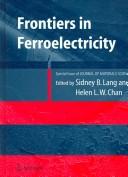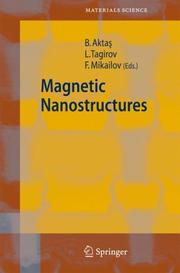| Listing 1 - 10 of 59 | << page >> |
Sort by
|
Book
ISBN: 1617617733 9781617617737 1608768457 9781608768455 Year: 2010 Publisher: New York : Nova Science Publishers,
Abstract | Keywords | Export | Availability | Bookmark
 Loading...
Loading...Choose an application
- Reference Manager
- EndNote
- RefWorks (Direct export to RefWorks)
Nanostructured materials --- Nanotechnology --- Nanomaterials --- Nanometer materials --- Nanophase materials --- Nanostructure controlled materials --- Nanostructure materials --- Ultra-fine microstructure materials --- Microstructure --- Research.
Periodical
ISSN: 16058127 Year: 2000 Publisher: [St. Petersburg, Russia] : [Germany] : [Advanced Study Center Co.] De Gruyter
Abstract | Keywords | Export | Availability | Bookmark
 Loading...
Loading...Choose an application
- Reference Manager
- EndNote
- RefWorks (Direct export to RefWorks)
Materials science --- Science des matériaux --- Periodicals. --- Périodiques --- Materials science. --- Material science --- Physical sciences --- high-melting point compounds --- metallurgy --- ceramics --- biological materials --- metals --- metallurgy --- ceramics --- polymers --- nanostructure materials
Periodical
ISSN: 22285059 Year: 2010 Publisher: Iran : Islam Azad University, Tonekabon Branch
Abstract | Keywords | Export | Availability | Bookmark
 Loading...
Loading...Choose an application
- Reference Manager
- EndNote
- RefWorks (Direct export to RefWorks)
Nanostructured materials --- Nanotechnology --- Nanostructured materials. --- Nanotechnology. --- Molecular technology --- Nanoscale technology --- Nanomaterials --- Nanometer materials --- Nanophase materials --- Nanostructure controlled materials --- Nanostructure materials --- Ultra-fine microstructure materials --- High technology --- Microstructure
Periodical
Abstract | Keywords | Export | Availability | Bookmark
 Loading...
Loading...Choose an application
- Reference Manager
- EndNote
- RefWorks (Direct export to RefWorks)
Nanostructured materials --- Nanostructures --- Nanostructures. --- Nanostructured materials. --- Nanoscience --- Physics --- Nanomaterials --- Nanometer materials --- Nanophase materials --- Nanostructure controlled materials --- Nanostructure materials --- Ultra-fine microstructure materials --- Microstructure --- Nanotechnology --- Nanostructured Materials --- Material, Nanostructured --- Materials, Nanostructured --- Nanomaterial --- Nanostructure --- Nanostructured Material --- Molecular Imprinting
Periodical
ISSN: 2423818X Year: 2016 Publisher: Tehran, Iran : Iranian Chemical Society,
Abstract | Keywords | Export | Availability | Bookmark
 Loading...
Loading...Choose an application
- Reference Manager
- EndNote
- RefWorks (Direct export to RefWorks)
nanochemistry --- nanotechnology --- Nanochemistry --- Nanoscience --- Nanostructured materials --- Nanochemistry. --- Nanoscience. --- Nanostructured materials. --- Nanomaterials --- Nanometer materials --- Nanophase materials --- Nanostructure controlled materials --- Nanostructure materials --- Ultra-fine microstructure materials --- Microstructure --- Nanotechnology --- Nano science --- Nanoscale science --- Nanosciences --- Science --- Nanoscale chemistry --- Chemistry, Analytic --- Analytical chemistry

ISBN: 1281336629 9786611336622 0387380396 038738037X Year: 2007 Publisher: New York : Springer,
Abstract | Keywords | Export | Availability | Bookmark
 Loading...
Loading...Choose an application
- Reference Manager
- EndNote
- RefWorks (Direct export to RefWorks)
The field of ferroelectricity is a very active one. Many hundreds of papers in this field are published each year and a large number of local and international conferences are held. The material in this book originally appeared in the Journal of Materials Science. The special issue entitled Frontiers of Ferroelectricity appeared as Volume 41, Issue 1 of the Journal of Materials Science in January 2006. Researchers and students should find great value in having this complete set of papers available in book form. The book presents theory, fundamentals and applications of ferroelectricity. It describes the current levels of understanding of various aspects of the subject as presented by authorities in the field. Reviews and research reports cover the spectrum of ferroelectricity. Topics include relaxors, piezoelectrics, microscale and nanoscale studies, polymers and composites, unusual properties, and techniques and devices. The information in this book is intended for physicists, engineers and materials scientists working with ferroelectric materials including ceramics, single crystals, polymers, composites and even some biological materials.
Ferroelectric crystals. --- Ferroelectricity. --- Nanostructured materials. --- Piezoelectric materials. --- Ferroelectric thin films. --- Piezoelectricity. --- Piezo-electricity --- Piezoelectric effect --- Pyro- and piezo-electricity --- Crystallography --- Electricity --- Pyroelectricity --- Thin films --- Materials, Piezoelectric --- Nanomaterials --- Nanometer materials --- Nanophase materials --- Nanostructure controlled materials --- Nanostructure materials --- Ultra-fine microstructure materials --- Microstructure --- Nanotechnology --- Ferroelectric effect --- Seignette-electricity --- Polarization (Electricity) --- Ferroelectrics

ISBN: 1280805323 9786610805327 3540493360 3540493344 3642080421 Year: 2007 Publisher: Berlin, Heidelberg : Springer Berlin Heidelberg : Imprint: Springer,
Abstract | Keywords | Export | Availability | Bookmark
 Loading...
Loading...Choose an application
- Reference Manager
- EndNote
- RefWorks (Direct export to RefWorks)
This volume, written by a team of foremost experts, addresses the exciting and rapidly developing topic of nanostructured magnetic materials. It combines modern topics in nanoscale magnetism with issues relating to the fabrication and characterization of magnetic nanostructures. The chapters describe a wide range of physical aspects, together with theoretical and experimental methods. "Magnetic Nanostructures" will be of interest to researchers and specialists both in academic and industrial research. Graduate students will also find in this book an accessible introduction to the essential issues.
Nanostructured materials --- Nanotechnology. --- Magnetic properties. --- Molecular technology --- Nanoscale technology --- High technology --- Nanomaterials --- Nanometer materials --- Nanophase materials --- Nanostructure controlled materials --- Nanostructure materials --- Ultra-fine microstructure materials --- Microstructure --- Nanotechnology --- Magnetism. --- Engineering. --- Optical materials. --- Magnetism, Magnetic Materials. --- Engineering, general. --- Optical and Electronic Materials. --- Optics --- Materials --- Construction --- Industrial arts --- Technology --- Mathematical physics --- Physics --- Electricity --- Magnetics --- Magnetic materials. --- Electronic materials. --- Electronic materials
Book
ISBN: 1281141186 9786611141189 161583141X 0387747788 038774777X 1441925716 Year: 2008 Publisher: New York, NY : Springer New York : Imprint: Springer,
Abstract | Keywords | Export | Availability | Bookmark
 Loading...
Loading...Choose an application
- Reference Manager
- EndNote
- RefWorks (Direct export to RefWorks)
Computational Methods for Nanoscale Applications: Particles, Plasmons and Waves presents new perspectives on modern nanoscale problems where fundamental science meets technology and computer modeling. This book describes well-known computational techniques such as finite-difference schemes, finite element analysis and Ewald summation, as well as a new finite-difference calculus of Flexible Local Approximation MEthods (FLAME) that qualitatively improves the numerical accuracy in a variety of problems. Application areas in the book include long-range particle interactions in homogeneous and heterogeneous media, electrostatics of colloidal systems, wave propagation in photonic crystals, photonic band structure, plasmon field enhancement, and metamaterials with backward waves and negative refraction. Computational Methods for Nanoscale Applications is accessible to specialists and graduate students in diverse areas of nanoscale science and technology, including physics, engineering, chemistry, and applied mathematics. In addition, several advanced topics will be of particular interest to the expert reader. Key Features: Utilizes a two-tiered style of exposition with intuitive explanations of key principles in the first tier and further technical details in the second Bridges the gap between physics and engineering and computer science Presents fundamentals and applications of computational methods, electromagnetic theory, colloidal systems and photonic structures Covers "hot topics" in photonics, plasmonics, and metamaterials.
Nanostructured materials --- Particles (Nuclear physics) --- Nanotechnology. --- Simulation methods. --- Molecular technology --- Nanoscale technology --- High technology --- Elementary particles (Physics) --- High energy physics --- Nuclear particles --- Nucleons --- Nuclear physics --- Nanomaterials --- Nanometer materials --- Nanophase materials --- Nanostructure controlled materials --- Nanostructure materials --- Ultra-fine microstructure materials --- Microstructure --- Nanotechnology --- Theoretical, Mathematical and Computational Physics. --- Mathematical physics. --- Physical mathematics --- Physics --- Mathematics
Book
ISBN: 3540851038 354085102X Year: 2008 Publisher: Berlin, Heidelberg : Springer,
Abstract | Keywords | Export | Availability | Bookmark
 Loading...
Loading...Choose an application
- Reference Manager
- EndNote
- RefWorks (Direct export to RefWorks)
see table of contents.
Nanostructured materials. --- Polymers. --- Polymere --- Polymeride --- Polymers and polymerization --- Macromolecules --- Nanomaterials --- Nanometer materials --- Nanophase materials --- Nanostructure controlled materials --- Nanostructure materials --- Ultra-fine microstructure materials --- Microstructure --- Nanotechnology --- Nanotechnology. --- Polymer Sciences. --- Soft and Granular Matter, Complex Fluids and Microfluidics. --- Molecular technology --- Nanoscale technology --- High technology --- Polymers . --- Amorphous substances. --- Complex fluids. --- Complex liquids --- Fluids, Complex --- Amorphous substances --- Liquids --- Soft condensed matter
Book
ISBN: 3540851054 3540851046 Year: 2008 Publisher: Berlin, Heidelberg : Springer,
Abstract | Keywords | Export | Availability | Bookmark
 Loading...
Loading...Choose an application
- Reference Manager
- EndNote
- RefWorks (Direct export to RefWorks)
Nanotechnology is the creation of useful materials, devices, and systems through the control of matter on the nanometer-length scale. This takes place at the scale of atoms, molecules, and supramolecular structures. In the world of chemistry, the rational design of molecular structures and optimized control of self-assembly conditions have enabled us to control the resultant self-assembled morphologies having 1 to 100-nm dimensions with sing- nanometer precision. This current research trend applying the bottom-up approach to molecules remarkably contrasts with the top-down approach in nanotechnology, in which electronic devices are miniaturizing to smaller than 30 nm. However, even engineers working with state-of-the-art computer te- nology state that maintaining the rate of improvement based on Moore’s law will be the most dif?cult challenge in the next decade. On the other hand, the excellent properties and intelligent functions of a variety of natural materials have inspired polymer and organic chemists to tailor their synthetic organic alternatives by extracting the essential structural elements. In particular, one-dimensional structures in nature with sophis- cated hierarchy, such as myelinated axons in neurons, tendon, protein tubes of tubulin, and spider webs, provide intriguing examples of integrated functions and properties. Against this background, supramolecular self-assembly of one-dimensional architectures like ?bers and tubes from amphiphilic molecules, bio-related molecules, and properly designed self-assembling polymer molecules has - tracted rapidly growing interest.
Nanostructured materials. --- Nanotubes. --- Nanomaterials --- Nanometer materials --- Nanophase materials --- Nanostructure controlled materials --- Nanostructure materials --- Ultra-fine microstructure materials --- Microstructure --- Nanotechnology --- Nanostructured materials --- Tubes --- Polymers. --- Nanotechnology. --- Polymer Sciences. --- Soft and Granular Matter, Complex Fluids and Microfluidics. --- Molecular technology --- Nanoscale technology --- High technology --- Polymere --- Polymeride --- Polymers and polymerization --- Macromolecules --- Polymers . --- Amorphous substances. --- Complex fluids. --- Complex liquids --- Fluids, Complex --- Amorphous substances --- Liquids --- Soft condensed matter --- Nanofibers. --- Fibers
| Listing 1 - 10 of 59 | << page >> |
Sort by
|

 Search
Search Feedback
Feedback About
About Help
Help News
News